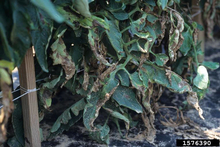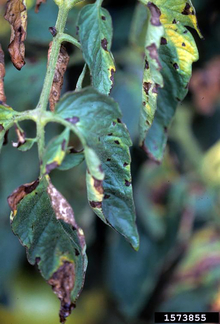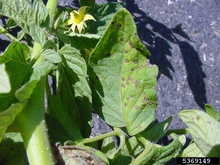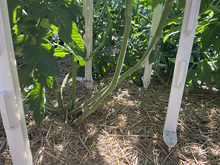Despite how dry much of the state is, we are still starting to see some common tomato diseases creeping in on Minnesota tomatoes. Seeing yellowing and spots appearing on the older leaves? Read on for a refresher on two fact-of-life fungal diseases in Minnesota tomatoes.
Two fungal diseases with similar life cycles
As tomatoes start to set fruit, gardeners often notice brown spots on the lower leaves. This can be caused by one of two fungal diseases: early blight or septoria leaf spot. They both like humidity and splashing water, so any time there is water on the leaf surface, these diseases can spread.
Early blight is the one most commonly seen tomato disease across Minnesota. The disease spores survive in crop debris and weeds, then infect this year's plants via splashing water. Early blight first infects the oldest leaves, with infected areas turning brown and developing concentric rings. Brown spots, also with concentric rings, can also be seen on stems. As time passes and leaves are wet, the disease can spread upward. Infected fruit develop leathery, dark spots and fall off the plant.
Septoria leaf spot has similar biology to early blight. The disease survives in the field on solanaceous weeds and infected plant material. As fruit starts to set, septoria is able to infect the oldest leaves. Septoria causes many small spots on the leaf, which are darkly colored, but as they expand can have tan centers. As time passes, the disease will move up the plant, though fruit infection is rare.
Managing leaf spot diseases
These diseases are a fact of life when growing tomatoes in Minnesota. The first step to managing them is keeping an eye on your tomatoes. How intensely you see these diseases is going to be garden specific – your local weather, tomato variety, and garden history are all going to influence if and when you see these fungal diseases.
The next step is giving your tomato the support they need to stay off the ground. The hot weather this summer has made garden work a little miserable, but it is still important to do garden maintenance.
- Remove weeds to promote airflow and reduce the amount of time it takes leaves to dry.
- Keep up with staking and tying tomatoes. Plants are growing like crazy right now, but continuing to provide plants with support again helps promote airflow and helps leaves dry out.
- As much of Minnesota continues to fall into a deeper drought, obviously watering is important, but how you water is also important. Again, these diseases thrive when leaves are wet. Water the base of plants so the water stays where it needs to be (the roots) and off of leaves where disease can develop.
- If you are lucky enough to get rain, stay out of the garden when leaves are wet, as this can help diseases move around.
As you do start to see leaf spots, the best way to deal with them is to pinch off spotted leaves and prune plants. You can remove up to a third of the tomato plant’s leaves without seeing a reduction in yield. This can be done preventatively, removing lower leaves to reduce the chance that leaves are splashed on and disease is spread. You can also prune in response to seeing diseased leaves.
Fungicides are typically needed to manage these diseases. Remember, fungicides don’t cure plants, so applying them once you see spots will only slow the disease’s spread. You can still produce an overwhelming number of tomatoes without fungicides.





